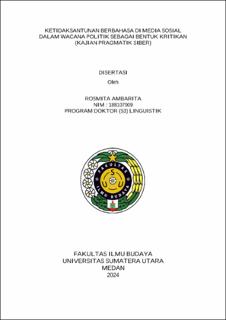| dc.description.abstract | This dissertation is concerned with the study of cyber pragmatics which analyzes
language impoliteness on social media as a form of criticism, namely netizen comments
on political discourse. Social media Instagram and Facebook are media for netizen
interaction which contain impolite comments. The aim of this research is to explain 1)
forms of impoliteness in netizens' language on social media in political discourse 2)
types of impoliteness in netizens' language on social media in political discourse 3)
patterns of using strategies of impoliteness in netizens' language on social media in
political discourse, and 4) analyzing factors -factors that trigger impoliteness in
netizens' language on social media in political discourse.
The main theory used in this research is the theory of impoliteness pioneered by
Culpeper (2011) which explains that impoliteness is communication behavior that aims
to attack the face of the interlocutor. The method used is a qualitative method, data
collected using a strict technique through screenshots or screen shoots and data on the
fourth problem formulation through a questionnaire in the form of a Google form.
The results of the analysis in the first problem formulation of cyber pragmatics in
the form of linguistic and non-linguistic features of language impoliteness found 3
forms of context, namely 66 (82.5%) utterances for social contexts, 8 (10%) utterances
for social contexts, and 6 (6 59%) speech for cultural context. The social context is
more dominant in analyzing the meaning of speech. The results of the analysis of 5
types of language impoliteness found in political discourse, namely 16 (47.06%) said
as KA, 4 (11.76%) said as KE, 12 (35.3%) said as KES, and 2 (5 .88%) said as KV. The
most dominant impolite speech is KA. The results of the analysis of 6 patterns of
linguistic impoliteness strategies found in political discourse, namely 11 (23.91%)
utterances for SL, 13 (28.26%) utterances for STL, 11 (23.91%) utterances for SP, 5
(10 .87%) said for SN, 5 (10.87%) said for SS, and 1 (2.17%) said for SPL. The most
dominant impolite speech is STL. The final results based on the most dominant or first
triggering factor were to criticize with 36% (n=36), factors showing disappointment as
much as 31% (n=31) with political discourse in different situations. The third trigger
factor is a form of incongruity as much as (n=17), then the fourth trigger factor is as
dislike as much as (n=7), the fifth trigger factor is as a result of anger as much as (n=4),
the sixth trigger factor is forms of incompatibility as many as (n=3), and the least
frequency of triggering factors are as forms of distrust, and annoyance respectively as
many as (n=1).
Based on the results of data analysis from all problem formulations, there are
several functions of language impoliteness, namely to criticize, be sarcastic and to
express anger and disappointment. | en_US |


